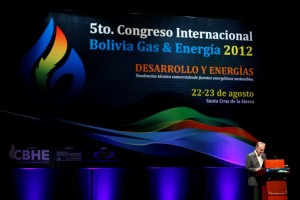Bolivia launched its energy plans last year in a bid to improve the country’s energy security by boosting self-sufficiency and diversifying resources.
Franklin Molina Ortiz, Deputy Minister of Energy Development, said at the Bolivia Gas and Energy International Congress that Bolivia would substantially increase its use of natural gas in the next two decades. He said that “in 2025 natural gas will make up 56% of Bolivia’s final energy consumption,” up from the current 21%. Although Bolivia does not import natural gas, it does import liquefied petroleum gas (LPG) for use in household cooking. In 2011 it imported 103 metric tonnes of LPG at a cost of US$48 million.
Bolivia is keen to exploit its homegrown natural gas. Carlos Delius, President of CBHE and Chair of WEC Bolivia, said: “Bolivia has huge amounts of [natural gas] resources, and Bolivia is prepared to convert these resources into reserves.”
Bolivia has one of the highest natural gas reserves of South America. According to the WEC’s 2010 Survey of Energy Resources, as at 2008 Bolivia had 710 billion cubic metres of proved recoverable natural gas reserves and in the same year produced 14.2 billion cubic metres of natural gas. This is equivalent to the potential to produce natural gas for 50 years at 2008 production levels.
Mr Delius added that Bolivia’s efforts to augment its natural gas reserves are happening in the backdrop of an increasingly competitive landscape, with competition especially coming from liquefied natural gas (LNG) and natural gas from an extensive layer of petroleum-rich salt formation (the “pre-salt” layer) off the south-east coast of Brazil. Therefore Bolivian natural gas developers “must be prepared” to be able to compete, Mr Delius told the conference delegates.
Alvaro García Linera, Bolivia’s Vice President, said the government was committed to strengthening the country’s capability in developing gas. He said at the conference: “The government this year has invested US$400 million in exploration and $2.4 billion in the whole production chain. The government has reiterated that its intention was to achieve an investment of $7 billion [between now and] 2015.”
Bolivia also plans to further develop its renewables resource. This is aimed not only to diversify supply, but also improve health.
Mr Franklin Molina Ortiz said Bolivia aims to reduce “considerably” the burning of firewood and to shift towards more sustainable forms of biomass. He expected Bolivia to produce 4% of Bolivia’s final energy consumption from biomass by 2025, which will be down from the current 16%. More than 90% of biomass used today is firewood, he said.
Wood fuels produce harmful smoke and pollutants. According to figures from the Global Alliance for Clean Cookstoves, one-third of Bolivia’s population of 9 million is affected by household air pollution. The new biomass target therefore “will involve the efficient introduction of alternative energy in different sectors for industrial or electrical generation,” Mr Molina said.
The energy plans are considered a key part of economic development for Bolivia, one of South America’s poorest countries. Vice President García Linera: “In future we see ourselves as an industrialised country and as an energy centre, linked to all world markets.”
The conference, which drew over 700 participants, also hosted an exhibition, where CBHE showcased the WEC’s global activities.






